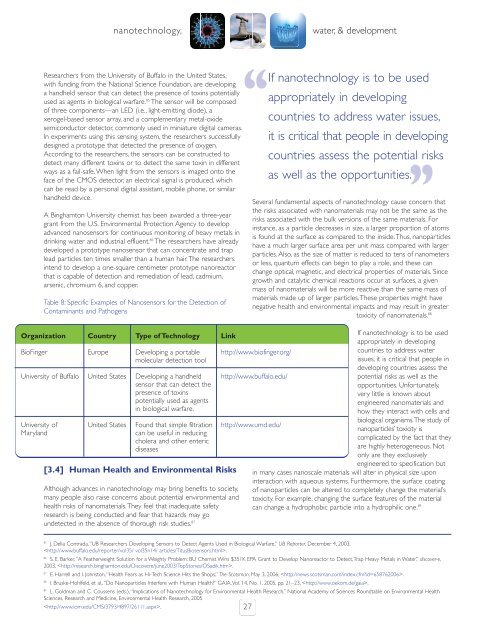Global Dialogue on Nanotechnology and the Poor ... - Nanowerk
Global Dialogue on Nanotechnology and the Poor ... - Nanowerk
Global Dialogue on Nanotechnology and the Poor ... - Nanowerk
You also want an ePaper? Increase the reach of your titles
YUMPU automatically turns print PDFs into web optimized ePapers that Google loves.
nanotechnology,<br />
water, & development<br />
Researchers from <strong>the</strong> University of Buffalo in <strong>the</strong> United States,<br />
with funding from <strong>the</strong> Nati<strong>on</strong>al Science Foundati<strong>on</strong>, are developing<br />
a h<strong>and</strong>held sensor that can detect <strong>the</strong> presence of toxins potentially<br />
used as agents in biological warfare. 85 The sensor will be composed<br />
of three comp<strong>on</strong>ents—an LED (i.e., light-emitting diode), a<br />
xerogel-based sensor array, <strong>and</strong> a complementary metal-oxide<br />
semic<strong>on</strong>ductor detector, comm<strong>on</strong>ly used in miniature digital cameras.<br />
In experiments using this sensing system, <strong>the</strong> researchers successfully<br />
designed a prototype that detected <strong>the</strong> presence of oxygen.<br />
According to <strong>the</strong> researchers, <strong>the</strong> sensors can be c<strong>on</strong>structed to<br />
detect many different toxins or to detect <strong>the</strong> same toxin in different<br />
ways as a fail-safe.When light from <strong>the</strong> sensors is imaged <strong>on</strong>to <strong>the</strong><br />
face of <strong>the</strong> CMOS detector, an electrical signal is produced, which<br />
can be read by a pers<strong>on</strong>al digital assistant, mobile ph<strong>on</strong>e, or similar<br />
h<strong>and</strong>held device.<br />
A Binghamt<strong>on</strong> University chemist has been awarded a three-year<br />
grant from <strong>the</strong> U.S. Envir<strong>on</strong>mental Protecti<strong>on</strong> Agency to develop<br />
advanced nanosensors for c<strong>on</strong>tinuous m<strong>on</strong>itoring of heavy metals in<br />
drinking water <strong>and</strong> industrial effluent. 86 The researchers have already<br />
developed a prototype nanosensor that can c<strong>on</strong>centrate <strong>and</strong> trap<br />
lead particles ten times smaller than a human hair.The researchers<br />
intend to develop a <strong>on</strong>e-square centimeter prototype nanoreactor<br />
that is capable of detecti<strong>on</strong> <strong>and</strong> remediati<strong>on</strong> of lead, cadmium,<br />
arsenic, chromium 6, <strong>and</strong> copper.<br />
Table 8: Specific Examples of Nanosensors for <strong>the</strong> Detecti<strong>on</strong> of<br />
C<strong>on</strong>taminants <strong>and</strong> Pathogens<br />
Organizati<strong>on</strong><br />
BioFinger<br />
University of Buffalo<br />
University of<br />
Maryl<strong>and</strong><br />
Country<br />
Europe<br />
United States<br />
United States<br />
Type of Technology<br />
Developing a portable<br />
molecular detecti<strong>on</strong> tool<br />
Developing a h<strong>and</strong>held<br />
sensor that can detect <strong>the</strong><br />
presence of toxins<br />
potentially used as agents<br />
in biological warfare.<br />
Found that simple filtrati<strong>on</strong><br />
can be useful in reducing<br />
cholera <strong>and</strong> o<strong>the</strong>r enteric<br />
diseases<br />
Link<br />
[3.4] Human Health <strong>and</strong> Envir<strong>on</strong>mental Risks<br />
Although advances in nanotechnology may bring benefits to society,<br />
many people also raise c<strong>on</strong>cerns about potential envir<strong>on</strong>mental <strong>and</strong><br />
health risks of nanomaterials.They feel that inadequate safety<br />
research is being c<strong>on</strong>ducted <strong>and</strong> fear that hazards may go<br />
undetected in <strong>the</strong> absence of thorough risk studies. 87<br />
‘‘<br />
If nanotechnology is to be used<br />
appropriately in developing<br />
countries to address water issues,<br />
it is critical that people in developing<br />
countries assess <strong>the</strong> potential risks<br />
’’<br />
as well as <strong>the</strong> opportunities.<br />
Several fundamental aspects of nanotechnology cause c<strong>on</strong>cern that<br />
<strong>the</strong> risks associated with nanomaterials may not be <strong>the</strong> same as <strong>the</strong><br />
risks associated with <strong>the</strong> bulk versi<strong>on</strong>s of <strong>the</strong> same materials. For<br />
instance, as a particle decreases in size, a larger proporti<strong>on</strong> of atoms<br />
is found at <strong>the</strong> surface as compared to <strong>the</strong> inside.Thus, nanoparticles<br />
have a much larger surface area per unit mass compared with larger<br />
particles. Also, as <strong>the</strong> size of matter is reduced to tens of nanometers<br />
or less, quantum effects can begin to play a role, <strong>and</strong> <strong>the</strong>se can<br />
change optical, magnetic, <strong>and</strong> electrical properties of materials. Since<br />
growth <strong>and</strong> catalytic chemical reacti<strong>on</strong>s occur at surfaces, a given<br />
mass of nanomaterials will be more reactive than <strong>the</strong> same mass of<br />
materials made up of larger particles.These properties might have<br />
negative health <strong>and</strong> envir<strong>on</strong>mental impacts <strong>and</strong> may result in greater<br />
toxicity of nanomaterials. 88<br />
If nanotechnology is to be used<br />
appropriately in developing<br />
countries to address water<br />
issues, it is critical that people in<br />
developing countries assess <strong>the</strong><br />
potential risks as well as <strong>the</strong><br />
opportunities. Unfortunately,<br />
very little is known about<br />
engineered nanomaterials <strong>and</strong><br />
how <strong>the</strong>y interact with cells <strong>and</strong><br />
biological organisms.The study of<br />
nanoparticles’ toxicity is<br />
complicated by <strong>the</strong> fact that <strong>the</strong>y<br />
are highly heterogeneous. Not<br />
<strong>on</strong>ly are <strong>the</strong>y exclusively<br />
engineered to specificati<strong>on</strong> but<br />
in many cases nanoscale materials will alter in physical size up<strong>on</strong><br />
interacti<strong>on</strong> with aqueous systems. Fur<strong>the</strong>rmore, <strong>the</strong> surface coating<br />
of nanoparticles can be altered to completely change <strong>the</strong> material’s<br />
toxicity. For example, changing <strong>the</strong> surface features of <strong>the</strong> material<br />
can change a hydrophobic particle into a hydrophilic <strong>on</strong>e. 89<br />
http://www.biofinger.org/<br />
http://www.buffalo.edu/<br />
http://www.umd.edu/<br />
85<br />
J. Della C<strong>on</strong>trada,“UB Researchers Developing Sensors to Detect Agents Used in Biological Warfare,” UB Reporter, December 4, 2003,<br />
.<br />
86<br />
S. E. Barker, “A Fea<strong>the</strong>rweight Soluti<strong>on</strong> for a Weighty Problem: BU Chemist Wins $351K EPA Grant to Develop Nanoreactor to Detect,Trap Heavy Metals in Water,” discover-e,<br />
2003, .<br />
87<br />
E. Harrell <strong>and</strong> I. Johnst<strong>on</strong>, “Health Fears as Hi-Tech Science Hits <strong>the</strong> Shops,” The Scotsman, May 3, 2006, .<br />
88<br />
I. Bruske-Hohlfeld, et al.,“Do Nanoparticles Interfere with Human Health?” GAIA,Vol. 14, No. 1, 2005, pp. 21–23, .<br />
89<br />
L. Goldman <strong>and</strong> C. Coussens (eds.),“Implicati<strong>on</strong>s of <strong>Nanotechnology</strong> for Envir<strong>on</strong>mental Health Research,” Nati<strong>on</strong>al Academy of Sciences Roundtable <strong>on</strong> Envir<strong>on</strong>mental Health<br />
Sciences, Research <strong>and</strong> Medicine, Envir<strong>on</strong>mental Health Research, 2005<br />
.<br />
27
















